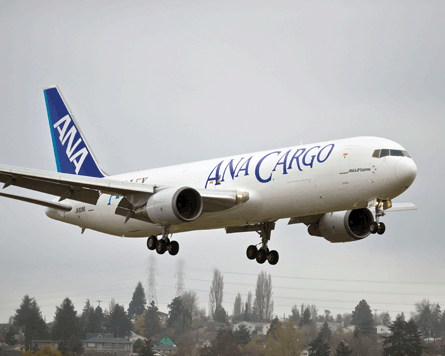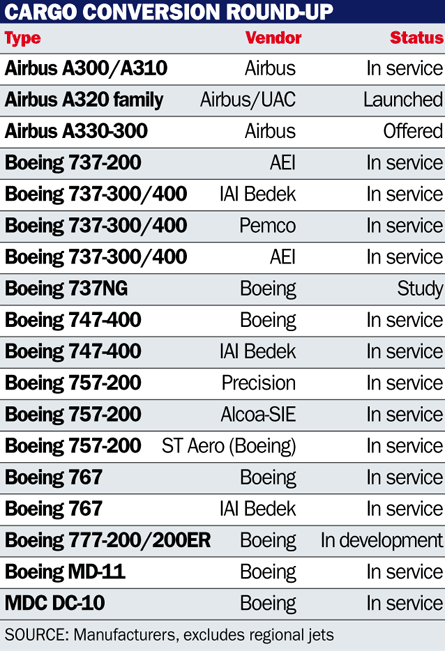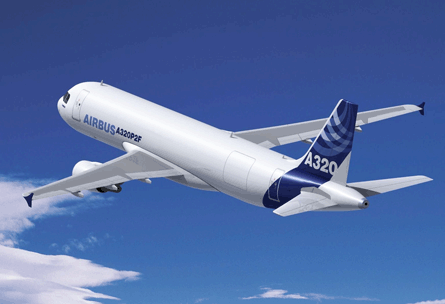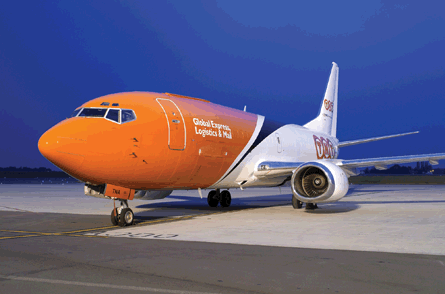This has not exactly been a stellar year for cargo conversions. The steep downturn in the cargo market has caused demand for passenger-to-freighter (P2F) conversions to evaporate. As a result the pace of work on several P2F conversion lines has slowed to a crawl and some lines have at least temporarily become inactive.
For example, only five Boeing 747-400 conversions were completed during the first three quarters of the year - three by Boeing at Taikoo (Xiamen) Aircraft Engineering (TAECO) and two by Israel Aerospace Industries' Bedek division. The production rate is also slow on the 767 P2F lines at Bedek and Boeing's partner Singapore Technologies (ST Aero) as well as on the A300/A310 line at EADS EFW.
Meanwhile, Boeing's DC-10/MD-11 conversion programme, which ST Aero and Aeronavali have counted on for years, has slowed to a trickle and is approaching its end. The narrowbody conversion market also has been hit by the downturn, with reduced 737/757 output this year at Bedek, Pemco, Precision Conversions and Aeronautical Engineers (AEI).
 |
|---|
© Boeing |
But there is hope in the horizon for cargo conversion providers. After almost a year of unprecedented traffic declines, the air cargo market seems to be bottoming out, stirring up interest again for conversions. The downturn in the passenger market has also driven down aircraft values and dramatically improved the feedstock for conversions. Perhaps most importantly there are new P2F programmes, most notably for the Airbus A330 and Boeing 777, which could provide important new business for some of the conversion shops.
777 BCF MOOTED
The industry has been waiting years for a 777 converted freighter and it appears the time has finally come. Boeing Commercial Aviation Services vice-president freighter conversions Dennis Floyd revealed at the Cargo Facts aircraft symposium in mid-September that it could launch a P2F product for the 777-200 and/or 777-200ER as early as next year with entry into service in 2013 or 2014. "The earliest we're looking at is first quarter of next year for it being offerable," says Floyd.
FedEx Express is already a customer for the new-build 777F and air operations division vice-president planning and performance Robert Rachor says the cargo carrier is evaluating both aircraft, with the 777-200BCF seen as a potential replacement for its DC-10-10s and the 777-200ERBCF seen as a potential replacement for its DC-10-30s.
FedEx chief executive David Bronczek calls the 777 "a perfect plane for us as a production freighter and as a converted freighter" and says the carrier is looking at making a decision on the 777 BCF "sometime next year".
Boeing sees the 777 converted freighter complementing rather than competing with the 777F, as the production aircraft is based on the larger 777-200LR/300ER. The 777F has a 347,800kg (766,000lb) maximum take-off weight and revenue payload of around 103t, which can be carried up to 9,250km (5,000nm). The 777-200ERBCF will have an estimated MTOW of 295,100kg and a revenue payload of around 79.5t that can be flown up to 7,400km. The 777-200BCF will have an estimated 247,300kg MTOW and revenue payload of around 68t at a range of 4,625km.
 |
|---|
Boeing plans to take the lead in marketing the 777BCF and use outside shops for the actual conversion, following the strategy it has used for the 747-400BCF and 767-300ERBCF programmes. "Our intent is to do it as a Boeing Converted Freighter contracted from us," says Floyd.
TAECO and ST Aero are obvious candidates to partner Boeing on the 777BCF, but the manufacturer also may separately sell kits to airlines that have their own conversion capabilities like it has done with Korean Air and Singapore Airlines on the 747-400. The president of ST Aero's Mobile Aerospace Engineering (MAE) subsidiary, Joseph Ng, says ST Aero "will certainly bid for the conversions".
The potential launch of a P2F conversion for the 777 comes just as Airbus prepares to launch a similar product for the rival A330. A P2F conversion for the A330-300 is already being offered and Airbus Freighter Conversion vice-president of marketing and sales Michael Fuerst says interest has been so strong that he is confident a launch order will be secured by the end of this year.
The A330-300P2F would have a payload of around 50-60t and is seen as potentially competing against the 777-200BCF to replace DC-10s, DC-8s, A300s, A310s and other intra-continental freighters. Airbus sees the converted freighter supplementing the higher payload, longer-range A330-200F, which is scheduled to enter service next August.
Fuerst says it is "important" Airbus launches the A330-300P2F this year because it has some customers interested in a combination of the A330P2F and A320P2F. The A320P2F is now scheduled to enter service in early 2012, the same year deliveries of the A330-300P2F could begin if a launch customer is secured, with the first A321P2F to follow at the beginning of 2013.
The A320/A321P2F was launched last year with an order for 30 conversions from lessor AerCap. Fuerst is confident a commitment from the first A320P2F operator will be in place by the end of this year. He says the launch operator will most likely be from Asia as there are four Indian carriers and several Chinese carriers now evaluating the type. Fuerst says Chile-based LAN also has expressed interest in the A320P2F.
First A320 IDENTIFIED
Meanwhile, the first A320 for Airbus's conversion to has been identified and "everything is prepared" for work to begin in January 2011 at EADS EFW in Dresden, says Fuerst. He says EFW is due to convert the first seven to eight aircraft in the new programme and complete a majority of the conversions until 2015, at which point the work will be shared on a 50/50 basis with Russian partner United Aircraft (UAC). But he says EFW is capable of picking up the slack if UAC's Irkut unit, which has been looking at changing the site for its conversions, meets any delays in spooling up its line.
 |
|---|
© Airbus |
With over 4,000 A320s produced to date Fuerst expects a steady feedstock and increasing demand as an estimated 500 narrowbody freighters will need to be replaced over the next 20 years. Airbus also sees the A320P2F meeting a looming requirement for growth aircraft as cargo traffic is expected to begin recovering next year. "We see increasing demand, especially in emerging markets such as China, India, Brazil and Russia," Fuerst says.
If Airbus is correct in its view that market conditions will soon be ripe for the A320P2F, the launch of a conversion product for the 737NG, which entered passenger service about five years after the A320, could also take place early next decade. "It's not far from coming into a viable conversion candidate as well," Floyd says of the 737NG, adding the exact timing will depend on market demand and feedstock.
Floyd shares Fuerst's view the cargo market will start to recover next year. Recent monthly traffic reports from the International Air Transport Association already show a bottoming out, with year-over-year freight-tonne kilometres declines of around 10% compared with the unprecedented declines that exceeded 20% late last year and through the first four months of this year.
This could create the demand for a launch of the 777BCF as the economic downturn has created some initial feedstock and driven down values to a point where conversions can be considered. With the DC-10/MD-11 conversion programme coming to a close - FedEx received its last MD-11 in September and Aeronavali is now working on the carrier's final batch of DC-10s, which will be re-delivered next year - there are fewer alternatives for conversions in this size category.
Boeing is also hoping the recovery in demand will spur new orders for the 747-400BCF and the 767-300ERBCF. Boeing has not secured new orders for either product in a couple of years. Following the re-delivery in October of the fourth aircraft, the backlog for the 767-300ERBCF now stands at 13 aircraft. Floyd says feedstock continues to be "sort of" a challenge for the 767 given the continued delays in the 787 programme, but a lack of demand has been the bigger issue over the last year.
Demand should start to improve next year and Floyd says Boeing also continues to study a possible conversion product for the non-ER version of the 767-300, which will be launched if there is market demand. For now ST Aero only has a single line converting 767s, according to Ng.
For the 747-400BCF, the backlog is down to 10 aircraft, with 39 aircraft delivered to date. Floyd says the 747-400BCF market is "challenging right now" and points to the unprecedented quantity of large freighters parked in the desert. But he says most of the 747s that are stored are -100/200s, and are not likely return to service when the market recovers.
Rival IAI Bedek has a similar view and believes demand for its 747-400BDSF, which Bedek corporate vice-president and general manager of marketing and business development Jack Gaber describes as "slow", will start to pick up next year. "There are now some freighters parked so we're competing with freighters coming back from the desert, which is affecting demand. I expect the situation to change in 2010," Gaber says. "The -200s will not come back and the -400 will be the aircraft. 2010 will be the turning point."
 |
|---|
© IAI |
He adds that Bedek, which to date has converted 18 747-400s, should be able to increase output again next year and re-deliver about six aircraft.
Bedek is also confident demand for its 767 and 737 products will pick up. Bedek has to date converted 40 767-200s and is now test flying its first 767-300ER as part of a new joint venture programme with Japan's Mitsui. Bedek plans to certificate the 767-300BDSF by year-end, but so far only two orders have been secured.
TWO ACTIVE LINES
For the 737-300/400 Gaber says Bedek has two active lines in Israel and one in China at Guangzhou Aircraft Maintenance Engineering (GAMECO). In previous years Bedek also used VEM in Brazil to convert 767s and Denel in South Africa to convert 737s, but these lines are now inactive. Gaber says Bedek will only resume outsourcing conversions to Brazil, South Africa and potentially other countries if it can again secure enough work to again fill its Tel Aviv facility.
Bedek also forged partnership early last year with Thai Airways to convert 747-400s in Bangkok, but Gaber says these plans are now on ice and Thai is "waiting for the economy to come back" before launching the project. Bedek before the downturn was also exploring opening a conversion line in North America. "We're still looking at that, but right now don't have demand to justify it," Gaber says.
AEI vice-president sales and marketing Robert Convey says the firm will go all of 2009 without re-delivering any aircraft, but says it will have three to four 737s undergoing conversion by the end of this year. Precision Conversions vice-president marketing and sales Brian McCarthy says the company's two Boeing 757-200 conversion lines also have been in a start-and-stop mode most of the year. Precision Conversions is scheduled to re-deliver two aircraft this week, ending a nine-month gap without any re-deliveries.
McCarthy says with 80-90 757s now in the desert, feedstock is not an issue, but demand has been slow and is responsible for the more than 50% reduction in output. "We were doing seven to eight a year in prior years and it just froze with the recession and tremendous falloff in cargo," McCarthy says.
 |
|---|
© TNT |
Alcoa-SIE Cargo Conversions, which has not completed any aircraft since it re-delivered its first and only 757-200 in early 2007, is also struggling. But SIE vice-president operations John Reinert says the firm is now working on a new supplemental type certificate for 15 pallets, matching the more successful Precision Conversions product, which to date has resulted in more than 20 deliveries. The 757 conversion that Alcoa-SIE is now offering has only 14.5 pallets.
MORE TO COME
"We want to offer another option and be more competitive with what the industry wants. There's a ton more to be done," Reinert says, adding that "hopefully now the economy is rebounding next year the market will be better".
McCarthy is also optimistic, saying Precision is close to closing on two new contracts covering aircraft that will be converted later this year. He says there are other opportunities he is now pursuing for early 2010, which "could represent the beginnings of a much better year for Precision".
AEI's Convey has a similar view, saying he now expects to re-deliver 10 737s in 2010. "Overall, I would say the conversion and freight market is on an upswing," Convey says. "2010 is shaping up to be a banner year."
He reveals AEI, which now converts 737-200s and 737-300/400s, is also now looking at launching two new conversion programmes with announcements expected before the end of this year.
ST Aero's Ng also sees increasing demand for 757 conversions. He says ST Aero, which has three 757 conversion lines in Alabama and one in Singapore that are now dedicated to converting aircraft for FedEx, says it is receiving enquires from potential new customers, mostly in Europe and some in Asia. He says ST Aero already has the tooling to open a second 757 line in Singapore if there is demand.
ST Aero has completed 14 757s for FedEx and is now turning out aircraft at a rate of about one a month. FedEx is already committed to converting another 73 757s at ST Aero and Rachor says the carrier is considering expanding the programme to include additional aircraft.
As Cargo Conversions president Rick Hatton points out, the 757s ST Aero is converting for FedEx "is probably the most active programme going on now" and is the exception in an otherwise dreary market.
"Two years ago I was saying if we had feedstocks and slot positions we were rocking and rolling. Two years later those are no longer issues. It's better to characterise today's market as no demand and absolutely no money," Hatton told the Cargo Facts symposium.
While the cargo conversion providers are hopeful the market is now starting to show some signs of recovery, the pace of the recovery could be slow. Guggenheim Aviation chief executive Steve Rimmer points out that "we've never seen this quantity of freighters before in the desert" and warns that "this time we won't see the market pick up fast because there's a lot of good quality aircraft in the desert".
DVB Bank managing director aviation industry research Bert van Leeuwen predicts it will be two to three years until airlines will again be "chasing converted freighters". He says DVB remains committed to converting six 747-400s at Bedek, but adds it is "not completely clear" when the bank will be ready to finally hand to Bedek the first aircraft, which was originally scheduled to be converted earlier this year.
"Demand is now an issue but that will change," van Leeuwen says. "Medium term we think demand for the 747 converted freighter will be there."
BOEING POLICY CLOUDS THIRD-PARTY OUTLOOK
Several cargo conversion providers have been hit hard by Boeing's new policy to charge for technical support for aircraft converted at shops that are not licensed by the manufacturer.
A large group of aircraft owners, including some of the biggest leasing companies, operators and conversion shops have protested vehemently against the new charges since they were introduced in April. But Boeing says it has no plans to change the policy, which includes a $150,000 annual charge for narrowbodies and a $250,000 annual fee for widebodies.
Conversion shops say the charge is hitting demand during an already tough period for the industry, causing existing customers to consider cancelling orders and scaring away some potential customers.
They say so far no operators have agreed to pay the fees despite the consequences of potentially being denied support from Boeing should a problem arise. But this has yet to become an issue because there have been only a couple of re-deliveries since its introduction.
Several of the affected owners and operators are hoping the conversion shops will reach a compromise with Boeing, perhaps by negotiating a one-off payment. The largest non-Boeing supported conversion shop, Israel Aerospace Industries' Bedek division, claims it is talking to the manufacturer about such settlement. "We're hopeful about finding a solution with Boeing to benefit the customers," says Bedek corporate vice-president and general manager of marketing and business development Jack Gaber.
But Boeing says there are no such negotiations and the only option for conversion shops is to pay a licensing fee or support the aircraft on their own. The shops say the licensing fee, which would require them to pay Boeing a portion of their intake for every conversion, would erase the cost advantage they have over Boeing's own products and kill demand. Shops say Boeing has underestimated the long-term impact on the policy, which potentially includes decreased values for their aircraft and more business for rival Airbus. They are instead looking for a short-term "money grab".
At the Cargo Facts aircraft symposium in September, Cliff Duke - chief executive Bedek 747-400 conversion partner Eolia Trading - complained that Boeing was refusing publicly to even discuss the new policy, calling it a "very unfair attack on non-OEM suppliers".
Boeing Commercial Aviation Services vice-president freighter conversions Dennis Floyd responded that "I'm not aware of any change in that policy" and said Boeing would address Duke's issues privately.
Sources say Boeing is not offering Duke a resolution and the manufacturer is standing firm. Two conversion providers attending Cargo Facts called the policy "extortion" and share Duke's view that it is as an attack on their cheaper solutions.
Boeing says the policy is in response to an increase in service requests it has received over the past decade and the manufacturer's support desk is typically called after an aircraft is converted. But the conversion shops say when their customers have problems they call the shops rather than Boeing.
Some of the shops expect their customers will continue to refuse to pay the new fee and question whether Boeing will carry out its threat to not support the affected aircraft, especially when the aircraft is owned or operated by some of the manufacturer's largest customers.
Source: Flight International























